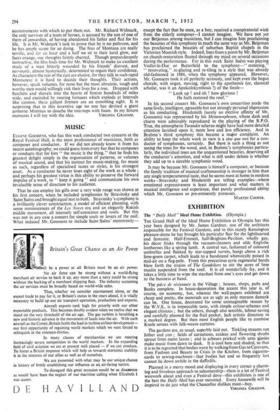MUSIC
EUGENE GOOSSENS, who has this week conducted two concerts at the Royal Festival Hall, is the most professional of musicians, both as composer and conductor. If we did not already know it from his recent autobiography, we could guess from every bar that he composes or conducts that for him " the music is the thing," that he finds his greatest delight simply in the organisation of patterns, or volumes of musical sound, and that his instinct for music-making, for music as such, regardless of specialised tastes or styles, is his strongest asset. As a conductor he never loses sight of the work as a whole ; and perhaps his greatest virtue is this ability to preserve the forward impulse of a work, to " keep it going " and communicate his own invaluable sense of direction to his audience.
That he can employ his gifts over a very wide range was shown at his first concert, when he included symphonies by Stravinsky and Saint Sans and brought equal zest to both. Stravinsky's symphony is a brilliantly clever construction, a model of efficient planning, with some reminiscences of the Les Noces era and an elegantly Rakish middle movement, all intensely self-conscious and voulu. But this was not in any case a concert for simple souls or lovers of the naif. What induced Mr. Goossens to include Saint Sans' monstrosity— except the fact that he once, as a boy, received a conspiratorial wink from the elderly composer—I cannot imagine. We have not yet our Betjeman among musicians, but I can imagine him proclaiming the beauties of this symphony in much the same way as Mr. Betjeman has proclaimed the beauties of suburban Baptist chapels in the Victorian Moorish style. Indeed, lines from a poem by Mr. Betjeman on church-restoration floated through my mind on several occasions during the performance. For in this work Saint Saens was playing Viollet-le-Due or Butterfield to the symphony—" restoring," " renovating," re-glazing and re-tiling in a style that was already old-fashioned in 1886, when the symphony appeared. However, Mr. Goossens took it all perfectly seriously, and kept even the bogus chorale, with organ, moving, right to the apotheosis (or, classical scholar, was it an Apokolokynthosis ?) of the finale- " Look up ! and oh ! how glorious !
He hath restored the roof."
In his second concert Mr. Goossens's own concertino made the same lively, intelligent, agreeable but not strongly personal impression as his conducting. Hindemith (surely an elective affinity of Mr. Goossens) was represented by his Metamorphosen, whose dash and charm were admirably reproduced in the playing of the R.P.O. True, the atmospheric Turandot scherzo might have had more detailed attention lavished upon it, more love and less efficiency. And in Brahms's third symphony this became a maior complaint. An ability to keep the whole work in view is a sine qua non for a con- ductor of symphonies, certainly. But there is such a thing as not seeing the trees for the wood, and, in Brahms's symphonies particu- larly, the individual trees are the unquestioned beauties, deserving all the conductor's attention, and what is still under debate is whether they add up to a sizeable symphonic wood.
It may be because Mr. Goossens is himself a composer, or because the family tradition of musical craftsmanship is stronger in him than any single temperamental taste, that he seems most at home in modern works—Stravinsky and Hindemith are telling examples—where emotional expressiveness is least important and what matters is musical intelligence and experience, that purely professional ability which Mr. Goossens so pre-eminently possesses.
MARTIN COOPER.


































 Previous page
Previous page